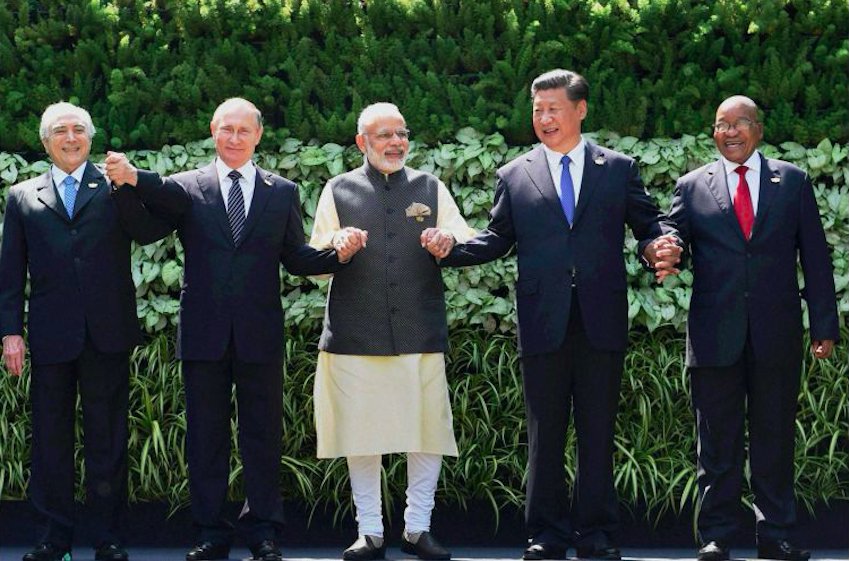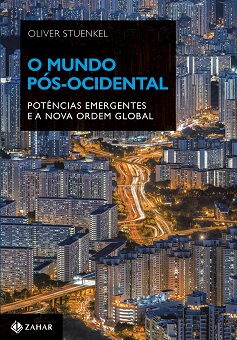
In Goa: Brazil’s Michel Temer, Russia’s Vladimir Putin, India’s Narendra Modi, China’s Xi Jinping and South Africa’s Jacob Zuma
Five years ago, in a column in the Financial Times, entitled “A Story of Brics without mortar”, Philip Stephens wrote that it was “time to bid farewell to the BRICS”. Since the group’s creation in 2009, the vast majority of international commentators have systematically argued that the BRICS club is nothing more than a fad. The fact that the BRICS’ member countries’ heads of government still decided to set up regular summits caught many by surprise, defying common sense: Why would national leaders waste their time flying around the world to meet with other emerging powers’ leaders that had been randomly thrown together by a British investment banker?
There were two reasons for this remarkable difference of interpretation. First of all, Western powers were reluctant to see the creation of any meaningful talking shop that excluded them. Seeking to draw a wedge between the BRICS members (particularly China and India) clearly was in the United States’ interest. In a conversation back then, a US diplomat put it bluntly: “What could we do to weaken Brazil’s commitment to the BRICS idea?” he asked me. Western powers sought to keep emerging powers from using the yearly BRICS summits to become influential agenda setters — a domain that is still controlled by the West.
The BRICS summits are not anti-Western in nature (indeed, many regard Brazil to be part of the West), but their final declarations are bound to differ from those of NATO or OECD summits. That is both necessary and natural: In order to solve global problems such as climate change, economic instability and failed states, rising powers need to be involved, and they should have every right to meet in whatever combination they see fit.
Secondly, asking whether the BRICS can turn into a traditional type of alliance à la NATO or EU is beside the point, and the question can easily lead to the conclusion that the BRICS initiative is not a worthwhile enterprise. (NATO emerged in the face of an existential threat, and the EU took many decades to become what it is today). If meetings help emerging powers exchange ideas, articulate common interests and debate common challenges, we may very well deem them a success. Whoever visits India, South Africa and Brazil will realize they share a considerable number of opinions and perspectives on global challenges, pointing to the vast potential for collaborating on how to tackle them.
This explains why, until today, analyses of the BRICS summits tend to be skewed — The Economist, for example, deemed the meeting in Goa as less important than the murder of a judge in Mexico or the fact that a Chinese spacecraft had docked successfully with a new spacelab. Russian and Chinese news media, on the contrary, provided overly positive analyses of the 8th BRICS Summit, failing to mention the difficulties and shortcomings as member countries sought to strengthen cooperation. As mentioned earlier, Indian newspapers such as The Hindu probably provide the most balanced analyses, given that it provides a perspective that is both non-Western but also concerned about the rise of China, i.e. not anti-Western, as several Russian publications tend to be.
The Goa Declaration
The BRICS’ summits’ final declarations matter. A study published this month by the University of Toronto shows that the BRICS achieved 78% compliance with the Ufa Summit Commitments made in 2015, continuing its high rate of compliance from previous summits. The report measures actions taken between 10 July 2015, immediately after the Ufa Summit ended, and 19 September 2016. (Scores may change in the future as new information becomes available.)
Over the past year, BRICS members did best on fulfilling their pledge on competition policy and on tax transparency, with 100% compliance. Members were almost as successful with their commitments on information and communications technology, international cooperation to fight terrorism, and cooperation on agriculture and food for vulnerable populations at 90%. The lowest score came on their regional security commitment on Iraq, at 30%.
The Goa Declaration (available here) is even longer than last year’s Ufa Declaration (available here), continuing a trend of the proliferation of intra-BRICS activities. While growing cooperation is to be welcomed in principle, diplomats from several countries privately affirm that several of the meetings lack substance and create an inflated sense of the breadth of intra-BRICS cooperation.
Multilateral institutions
Similar to all previous declarations, the BRICS’ Goa Declaration repeatedly underlines the grouping’s “commitment to the United Nations as a universal multilateral organization entrusted with the mandate of helping the international community maintain international peace and security, advance global development and promote and protect human rights.” Several paragraphs in the declaration are dedicated to specific UN agencies, such as UNCTAD, UNESCO and UNIDO, the UN Global Counter-Terrorism Strategy, the Financial Action Task Force (FATF) (paragraph 62) and UN Convention against Corruption (UNCAC). In the same way, the BRICS affirm their commitment to the World Trade Organization (WTO) (paragraph 34) and Bretton Woods: “We reaffirm our commitment to a strong, quota based and adequately resourced IMF.” (paragraph 30) That points to a reality often overlooked by Western analysts: The BRICS countries do not seek to overthrow global order; rather, they seek to reform some existing structures or create complementary ones. None of the BRICS grouping’s proposals question the basic rules and norms that undergird today’s global order, and the legitimacy of key institutions, such as the UN Security Council, is not questioned.
No consensus vis-à-vis UN Security Council Reform
The Declaration says that “China and Russia reiterate the importance they attach to the status and role of Brazil, India and South Africa in international affairs and support their aspiration to play a greater role in the UN.” (paragraph 10). The wording is exactly the same as in previous declarations (such as the eThekwini Declaration of 2013. That means that Beijing and Moscow do not openly support Brazil’s and India’s bid for a permanent seat on the UN Security Council. Given Brazil’s and India’s membership of the G4 grouping which includes Japan, China’s resistance is unlikely to change anytime soon. Indeed, Russia and China are far more instrumental in blocking reform than is generally thought. That does not mean that intra-BRICS cooperation is doomed: after all, Rome is opposed to Berlin’s UNSC ambitions, yet they successfully cooperate on many other issues.
Terrorism
As is the case with the G7 and the G20 summits, the host government is able to frame the debates and usually uses the meetings to promote specific issues it cares about. In the case of the Goa Summit, the Indian government had two key objetives. First of all, it sought to present itself as the poster child of the emerging world, growing at almost 8% despite global economic stagnation. Second of all, India sought to use the meeting to isolate Pakistan and depict the government in Islamabad as unwilling and incapable of successfully combating terrorism. While the first goal was undoubtedly reached, India was unable to convince the other BRICS members to include a specific reference to Pakistan or Lashkar-e-Taiba in the final declaration, which generated ample criticism in the Indian media — particularly considering that Russia insisted on including ISIL/Daesh and Jabhat al-Nusra (paragraphs 14 and 61). Added to India’s exasperation after Russia-Pakistani military exercises just before the summit, this led the Times of India to blast the Goa Declaration, saying “China bulldozed India’s security concerns as Russia looked the other way.”
A BRICS-led rating agency?
Should BRICS countries have their own rating agency to break the monopoly of the “Big Three” (Moody’s, Standard and Poor’s and Fitch)? This question has been a frequent topic of debate during the weeks prior to the Goa Summit. While several politicians are supportive of the idea, many experts have dismissed it. In Brazil, the Foreign Minister agreed, while the Central Bank and the Ministry of Finance thought it made little sense. Similar divisions exist in other countries (though Russia and India are more favorable to the idea than China), which explains a cautious note on the subject:
We welcome experts exploring the possibility of setting up an independent BRICS Rating Agency based on market-oriented principles, in order to further strengthen the global governance architecture. (paragraph 44)
Considering that the next summit will take place in Xiamen (China), it is far from certain whether the new rating agency will be created anytime soon. At the same time, the fact that the idea made it into the final declaration shows that it was influential supporters in the group.
India’s bid to join the Nuclear Suppliers Group (NSG)
In addition to showcasing India’s growth and isolating Pakistan, India sought to shore up support among BRICS countries to enter the Nuclear Suppliers Group (all other BRICS countries are part of it). Modi did manage to generate what it sees as a favorable response to India’s NSG membership bid. “We underline the importance of predictability in accessing technology and finance for expansion of civil nuclear energy capacity which would contribute to the sustainable development of Brics countries”, the declaration said (paragraph 54) — precisely the text India had suggested. Still, Xi Jinping remained non-commital during a bilateral meeting on the sideslines of the summit.
Trade facilitation
The Goa Declaration points to several measures to reduce non-tariff barriers to facilitate trade between the BRICS countries. The final text refers to the
establishment of the Customs Cooperation Committee of BRICS, and on exploring means of further enhancing collaboration in the future, including those aimed at creating legal basis for customs cooperation and facilitating procedures of customs control. (paragraph 48)
That is less than what some had hoped and points to continued resistance in several of the BRICS capitals. China had initially proposed talks about a BRICS free-trade agreement soon realized that was too ambitious. Considering that even smaller groups (such as IBSA) struggle to advance much in the trade realm (see also “Why is there still no IBSA free-trade agreement?“), the focus in the coming years will most likely be on the reduction of non-tariff barriers.
Additional initiatives
As most previous declarations, the Goa document includes a range of new ideas and projects, some useful (e.g. stronger cooperation on anti-terrorism), others somewhat quirky (a BRICS Football tournament). Either China in 2017 or South Africa in 2018 may consider reducing the number of activities to allow a stronger focus on a few priorities such as education, urban development, public health, infrastructure and so on.
The history of the BRICS grouping can be divided into three phases. In the first phase (2001-2007), “BRIC” (then still without South Africa) stood for little more than an investment category invented by Goldman Sachs. The second phase (2008-2014) saw the emergence of the BRICS as a political platform, though of largely informal nature. 2015 began the transition to a third phase, marked by a process of institutionalization and the launch of the New Development Bank and the Contingent Reserve Agreement. Institutionalization generates ample opportunities, but also global expectations, making it easier to judge the grouping’s performance and capacity to address global challenges. Examples include cooperation in education. The Goa Declaration states that
We are satisfied with the progress of the BRICS Network University (BRICSNU) as well as the BRICS University League (BRICSUL), which will commence their programmes in 2017. These two initiatives will facilitate higher education collaboration and partnerships across the BRICS countries. (paragraph 78)
Civil society, academia and the media must monitor these activities and verify whether they generate real benefits (e.g. do they boost the number of exchange students?), or whether they amount to little more than symbolism.
While many observers still regard the BRICS Summit through an unhelpful ‘West vs. rest’ lens, it will become increasingly clear that successful intra-BRICS cooperation is to be welcomed and has a positive impact on global order. To begin with, making use of the untapped potential of trade between BRICS countries will be key to avoid what Larry Summers calls “secular stagnation” and enhance trade between countries that are not as reluctant to embrace globalization as many Western powers. In addition, more effective cooperation between India and China will be crucial to avoid geopolitical tensions or even armed conflict in Asia in the coming years and decades — a scenario that would cause a global recession, considering how much the world economy is centered around Asia. A yearly summit alone, of course, is not enough to address such a monumental and long-term challenge. But promoting intra-BRICS cooperation is certainly a step in the right direction.
Read also:
The eThekwini Declaration: An analysis
Time to bid farewell to the BRICS? Not so fast.
What to Expect From the BRICS Summit in India
What can the 2012 BRICS Summit in New Delhi achieve?
South-South cooperation: Towards a new paradigm?
Photo credit: PTI








